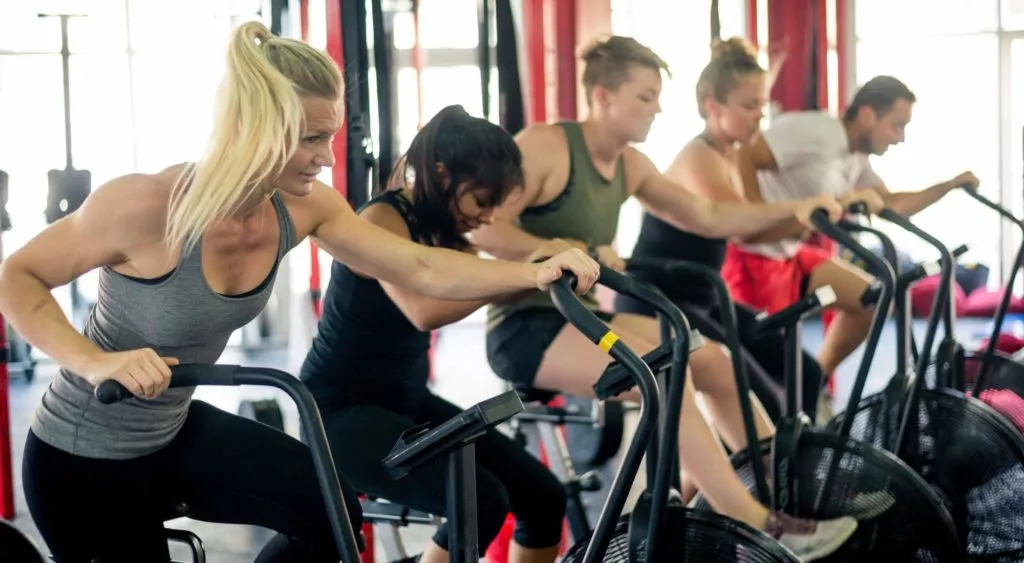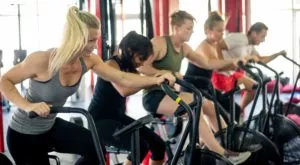
Let’s face it — a very small percentage of people are serious athletes.
If you’re hitting the gym or doing a home workout it most likely isn’t to train for your next pro football game or cycling race.
Maybe you’re a grandmother who wants to be able to keep up with your grandkids at the playground. Functional strength training can help.
Maybe you’re a UPS delivery driver and lifting boxes and climbing the steps back to your truck isn’t as easy as it used to be. Functional strength training can help.
Sensing a common theme?
Whatever your situation, or your ‘why,’ functional strength training is a great way to get your body moving:
- Effectively
- Efficiently
- Without pain
This guide explains how.
Contents
- What is Functional Strength Training?
- Who is Functional Strength Training For?
- Functional Strength Training For Older Adults
- Functional Strength Training For Athletes
- Purpose of Functional Strength Training Exercises
- How Often Should You Do Functional Strength Training Workouts?
- Functional Strength Training Equipment
- 6 Functional Strength Training Benefits
- Delaying the Effects of Age-Related Muscle Atrophy
- Increases Coordination And Agility
- Improves Balance
- Strengthens Core
- Reduces The Risk Of Injury
- As You Get Stronger, Pain Levels Decrease
- Call In Motion O.C. For Functional Athletic Strength Training
What is Functional Strength Training?
Functional strength training is defined as: “Training that attempts to mimic the specific physiological demands of real-life activities.”
More simply, it means using the body the way it was designed to be used.
This type of training can:
- Make everyday activities easier
- Reduce the risk of injury
- Improve your quality of life
Functional strength training focuses on exercising several muscle groups and joints together, rather than isolating a specific muscle or group of muscles.
Who is Functional Strength Training For?
In short, functional strength training is for everyone.
It is a great exercise option and benefits people of:
- All ages
- All fitness levels
As always, it’s important to consult a physician or licensed fitness trainer before beginning a strength training program, especially if you don’t exercise consistently.
Additionally, once given the go-ahead for functional strength training, beginners should use only body weight. As you build strength you can add resistance using additional weights or resistance bands.
Functional Strength Training For Older Adults
Functional strength training may be especially beneficial as part of a comprehensive program for older adults to:
- Improve balance
- Improve agility
- Increase muscle strength
- Reduce the risk of falls
Functional Strength Training For Athletes
Functional strength training is also ideal for athletes training for a specific sport.
This is because functional strength training programs can be tailored to the type of movements each athlete uses.
For example, functional strength training for triathletes will look different than functional strength training for tennis players.
Purpose of Functional Strength Training Exercises

Functional exercises tend to use multiple joints and numerous muscles. It’s a great way to engage and activate your entire body at one time.
For example, a functional exercise might involve the elbows, shoulders, hips, knees, and ankles simultaneously.
Think about walking into a typical gym. If you want to strength train you might head over to the weight racks stacked with dumbbells. Or maybe you’d start with bench pressing a barbell.
But think about your daily life. Does benching a bar or curling a 15-pound dumbbell mimic the things you do each day? Most likely not.
Edgar, In Motion O.C.’s Director of Fitness, says:
“Carrying around barbells and dumbbells is not the way the body was designed to be used. The fitness coaches at In Motion O.C. recommend functional exercises that move the body in the way it is supposed to be moved.”
Functional fitness means moving mindlessly.
What Does Moving Mindlessly Mean?
Think about these movements:
- Squat
- Lunge
- Push
- Pull
- Twist
These are the movements required to do the things you do every single day. Things like:
- Walking around
- Getting up out of a chair
- Squatting down to tie your shoes
- Reaching for something on a shelf
- Carrying something heavy from one room to another
- Turning at your waist to see something behind you
You don’t think about your movements when you do those things. You just do them. You move mindlessly.
Let’s look at this another way.
Think about how kids move. Kids move mindlessly. When they run, jump, play, and pick things up they aren’t “in their heads.” They aren’t thinking about those movements.
This concept of moving mindlessly, or moving naturally, is key when it comes to functional strength training.
But we get it — while moving mindlessly is the goal, figuring out how to do that at the gym can sound like a stressful undertaking. Here’s the thing — creating a functional fitness plan doesn’t have to be stressful.
Let In Motion O.C. take care of it.
Our fitness coaches are pros at designing functional strength training workout plans. They’ll tailor a program aimed at building strength and increasing mobility, helping you move through life efficiently and pain-free.
We’ll help you improve your overall fitness and achieve your specific health goals.
Book your free consultation with In Motion O.C. and get started the right way.
How Often Should You Do Functional Strength Training Workouts?
Because functional movements mimic your everyday activities, you can perform functional strength training workouts frequently without concern for injury. Ideally, you’d be doing these workouts 2-3 times each week.
However, that doesn’t mean you need to haul yourself to the gym that frequently.
Functional Strength Training Equipment
No need for machines, no need for barbells.
So, what do you need for functional strength workouts?
When it comes to functional strength training equipment, you can keep it pretty simple.
Most functional exercises use body weight for resistance. This means you can do these exercises anywhere, including at home or in a park.
In addition to body weight, some exercises might also incorporate:
- Weights
- Kettlebells
- Medicine balls
- Resistance bands
- Pull-up bars

6 Functional Strength Training Benefits
So, why train with function in mind?
There are many benefits to this type of strength training. They include:
- Delaying the effects of age-related muscle atrophy
- Increases coordination and agility
- Improves balance
- Strengthens your core
- Reduces risk of injury
- Reduces pain as you gain strength
#1: Delaying the Effects of Age-Related Muscle Atrophy
Muscle atrophy is a decrease in muscle mass. With this loss of muscle mass comes a loss of strength. The medical term for this is sarcopenia.
After middle age, adults lose on average, 3% of their muscle strength each year. Over time, this can make routine activities more difficult.
The best way to combat this muscle loss is exercise.
That’s because, in addition to age, inactivity is one of the major causes of muscle loss. You know the saying:
Use it or lose it.
Functional strength training has been shown to dramatically slow the rate of muscle loss and even reverse it.
#2: Increases Coordination And Agility
Coordination is defined as:
“The ability to use different parts of the body together smoothly and efficiently.”
Agility, meanwhile is:
“The ability to move quickly and easily.”
With the help of jumping, squatting, lunging, and other exercises, functional strength training can improve both your coordination and agility.
#3: Improves Balance
Functional strength training is practiced through compound movements. These compound exercises improve balance.
This benefit is helpful for everyone, but especially older adults as improved balance can reduce the risk of falls.
#4: Strengthens Core
When you think about strengthening your core, your abdominal muscles may come to mind.
But your core is so much more than that.
In fact, your core is composed of as many as 35 different muscle groups running from your torso to your hips.
Most full-body movements depend on a strong core.
Think of your body as a building. A strong foundation is essential to hold a building up and keep it safe. Your core is your body’s foundation.
If you’re injured or live in pain, you probably don’t have a strong foundation.
This is where functional strength training comes in. When you activate multiple muscle groups at once, you increase core stability.
Having a stronger core and supported body helps to prevent pain when performing everyday tasks.
#5: Reduces The Risk Of Injury
Functional strength training exercises keep your joints active and stable.
Building functional strength and mobility reduces your risk of injury and additional stress on your body.
Here are just a few examples:
- Squats – improve knee strength and mobility, reducing the risk of knee pain or injury.
- Planks – strengthen the core reducing lower back pain and injury.
- Exercise Bike – riding a stationary exercise bike is a natural motion (after all, you did it as a kid!) that serves as a great warm-up before strength training.

#6: As You Get Stronger, Pain Levels Decrease
Do you struggle with chronic pain or injury?
Don’t let this sideline you from exercise. Don’t trade in the gym or the local park for your couch.
Rest is important when nursing an injury, but with the proper guidance from a physical therapist or certified fitness coach, functional strength training can help too.
Functional fitness is all about making your everyday movements pain-free.
As you get stronger, your body will move more efficiently. In turn, your level of pain will decrease.
As Edgar, In Motion O.C.’s Director of Fitness, says:
“If you can move through life efficiently and safely doing the things you want and need to do, you’re strong.”
Call In Motion O.C. For Functional Athletic Strength Training
If you’re still unsure about how to create a functional strength training plan that best fits your goals and your lifestyle, don’t worry!
That’s where we come in.
In Motion O.C. offers several fitness programs featuring workouts co-designed by physical therapists, postural specialists, and fitness coaches.
Just a few of the programs we offer include:
- Women’s Health
- Back Health
- Performance Therapy
- Runner’s Analysis
- Hip Rehabilitation
- ACL Injury Prevention
All of our programs condition the body through functional fitness training.
Our goals are to help our clients:
- Look and feel better.
- Improve their posture, balance, flexibility, cardiovascular endurance, and function.
- Prevent reoccurrence of pain and injury.
Let us help you reach your goals.
Whether it’s increasing agility to improve your weekly tennis game, or gaining strength to make everyday tasks like walking up the stairs easier, we’re here to support you.
We believe functional strength training, combined with a good nutrition program, and our expert guidance, is the most effective way to help you achieve results.
Don’t waste another minute. Contact us to schedule your free consultation.
You’ve got nothing to lose and everything to gain.



